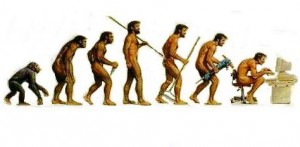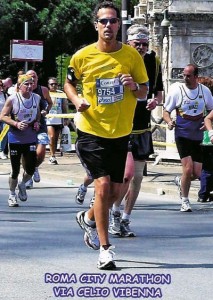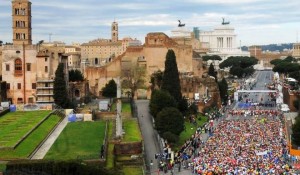Ten years ago I was completely obsessed with long distance running. I was living in Florida at the time, and every day I would wake up early and just run miles and miles and miles and miles for no apparent reason—in a Forrest Gump sort of way. Eventually these obsessions led to me enter the 2006 Rome Marathon. (In case you’re wondering, no, I didn’t even scare the Kenyan contingent at the front of the pack. Indeed, they nearly lapped me.)
Then several months ago with the big 5-0 on the near horizon, I decided that I’d better “get running” again, if only to keep up with my two year-old figlia, Demetra, who was born with the boundless energy of a hummingbird after three shots of espresso.
Coincidentally, last month I came upon an old piece that I had written for a creative writing class that I was taking during the time of my running obsession. Luckily I had a talented, enthusiastic instructor who was very encouraging towards my writing efforts. (Her name is Victoria Fedden, and she’s an accomplished writer with several books to her credit, as well as a very entertaining blog.)
Anyway, after re-reading the story again, I thought it would be fun to bring it up to date and moved the location from Florida to Rome. In fact, as you’ll see below, the “living timeline of history” that exists in Rome makes it a much better setting for the piece.
Take your mark, get set… GO!!!
Running Through History in Rome
A single beam of golden sun shoots through a crack in the tapparella, the rolling window shutter, and I hear church bells in the distance. No need to look at the clock; my body knows what time it is.
Quietly I sneak out of the bedroom and find my running shoes next to the front door, where I left them the night before. I lace them up, and slip into the pre-dawn half-light.
Just outside of my apartment building the ancient city stretches and yawns and comes to life. Delivery trucks double park to drop off their goods. Taxi cabs honk their horns in protest while motorini use the sidewalk to get around the blocked road.
I don’t take a coffee—not yet. In any case, the strong smell of steaming espresso floats towards me from every open door. I close my eyes for a moment, breathe in the aroma, and then break into a slow trot. I focus on the cadence, the steady rhythm of my footfalls. The hard part is already over.
Most people find long distance running boring and monotonous. But that is precisely the point: the monotony functions like a mantra that empties my mind of all its background chatter and allows me to be more present. Once I push through the initial barriers, “boring” becomes hypnotic. Then I keep running farther still, because I know just beyond that final cognitive boundary is where the really interesting things can happen.
*
As it turns out, evolution specifically designed human beings for long distance running. Our inner caveman still craves it the way birds need to fly. Over the millennia, civilization has made it no longer necessary, even though our essential biology hasn’t changed.
In fact, for long distances, humans are the champions of the animal kingdom. In races of 50 miles or more, a well-trained man (or woman) will defeat a horse nine times out of ten. It’s built into our DNA, and to suppress it denies our very nature, upsetting a crucial balance in our brain chemistry.
200,000 years ago, two types of hominids roamed the planet: our evolutionary ancestors and the Neanderthals. The two species lived side by side for thousands of years until the Neanderthals eventually disappeared.
The Neanderthals had every advantage—they were bigger, stronger, and more intelligent. And yet, nature selected them for extinction while our forefathers went on to create civilization. But why? What did humans have that the Neanderthals lacked?
Simply put, according to one leading theory of anthropology, our ancestors were good runners and the Neanderthals were not.
Centuries before the development of tools or weapons, prehistoric man employed a technique known as the “persistence hunt.” Entire clans of men, women, and children would take off on foot to follow a herd of antelopes or some other game across the plains.
At some point, a small group of strong young men would run into the herd and separate one of the animals from the pack. Then over the course of many hours, they would simply chase the animal down until it died of exhaustion. In a short sprint, antelopes are much faster than humans. But they lack endurance, so the struggle for survival becomes a test of persistence—just keep running until either you or your prey drops dead.
Scientists have found evidence of this behavior all over the world. In fact, there are still a few isolated tribes in both Africa and South America that continue to use this technique today.
Yet the desire to run remains inside every human. We all experienced the unbridled joy of running when we were small children. Running meant freedom back then, when the power of your own two feet could magically transport you from where you were to where you wanted to be—even if that distance was only the length of a playground.
Then eventually the responsibilities of adulthood get in the way, and we all slow down and tend to our obligations. We drive our kids to school, even if it’s only a kilometer away. We shop online instead of walking to the outdoor markets. Modern culture has suppressed our inherent programming, the desire to run. But it is still there, if dormant, deep within our genetic material.
*
 Exercise physiologists often speak of a “runner’s high,” but I’ve always found that term to be a bit misleading. A “high” suggests some sort of giddy intoxication, but what actually occurs is more sedate and transcendental, akin to the altered plane of consciousness achieved by decades of meditation practice. Running is a shortcut to this peaceful state; a gradual suspension of reality, where you ultimately come to feel like a passenger in your own body. Something else is in control, and your brain is just along for the ride.
Exercise physiologists often speak of a “runner’s high,” but I’ve always found that term to be a bit misleading. A “high” suggests some sort of giddy intoxication, but what actually occurs is more sedate and transcendental, akin to the altered plane of consciousness achieved by decades of meditation practice. Running is a shortcut to this peaceful state; a gradual suspension of reality, where you ultimately come to feel like a passenger in your own body. Something else is in control, and your brain is just along for the ride.
When I first set out on a long run, the first few strides are always uncomfortable and I feel every bit of a 49 year-old, 21st century man. My muscles are stiff and my joints creak like a rusty door hinge. My breathing is irregular and my heart pounds spastically off rhythm, as my whole body unites in protest for being called to task so early in the day. Those first 10 or 15 minutes are pure drudgery as I struggle to throw off the restraints; the consequences of a modern, sedentary lifestyle.
Then after about 20-25 minutes or so, things smooth out and I perceive a slow trickle of adrenaline into my bloodstream. The prehistoric animal inside of me stirs. He has powers far beyond my own, and I will call upon that strength again and again over the course of the next two or three hours. He prods me to keep up with the pack, to focus on the hunt.
By the time I reach 40 minutes he’s running right beside me. His effortless, loping strides accelerate, challenging me to match his pace. And once I’ve gone over the one hour mark, I don’t notice him at all anymore. We’re in perfect sync and the distinction between him and I has dissolved entirely.

Then the illusion surges deeper and I feel invincible, immortal. I want to be put on a treadmill that’s hardwired to a massive generator and tapped into the local power grid so I can light up my entire neighborhood like a slot machine that’s just hit the jackpot. Keep me hydrated and feed me some more of that space-age, carbohydrate energy gel and I’ll keep churning away while admiring the orange halo above the city coming from the street lamps that I’m setting on fire. Throw open all your windows, crank up your A/C units to full blast; let me hear the sound of 10,000 TVs and stereos screaming in unison. Let me feel the hum of electricity that I’m generating and I’ll run faster still, straining the transformers to their capacity. The animal has been released and he wants to keep running. He wants to run back to a time when social media connections, virtual reality, and digitally enhanced lifestyles didn’t exist.
I break free of the city limits and glide through the wilderness. The clatter of cars and sirens and horns and humans diminish to a muted hush. The only sound is my own steady heartbeat, like the drone of a piston tapping on the inside of my eardrums.
Hours pass in seconds and I have completely lost track of where I am. There are no more landmarks, only open space. Grass, shrubbery, gravel, a mound of dirt. A small settlement on a distant hill, too far away to identify.
I reverse my course and accelerate, barely touching the ground with my feet.
 Now the landscape speeds by in blurry frames of disjointed scenery: an Etruscan tomb, then a Roman aqueduct, a Medieval wall, a Baroque fountain, and finally in the distance the Fascist-era concrete block where I live. Civilization. The cacophony of noise comes back at me in a rush.
Now the landscape speeds by in blurry frames of disjointed scenery: an Etruscan tomb, then a Roman aqueduct, a Medieval wall, a Baroque fountain, and finally in the distance the Fascist-era concrete block where I live. Civilization. The cacophony of noise comes back at me in a rush.
With a deep groan, I slow my gait to a clumsy trot. The sunglasses come off and I wipe the salty sting from my eyes as I try to establish my bearings. I am suddenly aware of the weight of my clothes, saturated with my own perspiration. Walking now, I concentrate on my breathing again as my prehistoric alter ego slinks back into his cave.
*
Night arrives and I look out of my window at the blazing lights of The Eternal City. The sun set an hour ago, but the infernal steam of summer heat lingers up here on the Caelian Hill. At least my glass of Frascati wine is cold—so I just sit and drink while Rome burns around me.
The same church bells that woke me up in the morning now try to sing me good night. My eyes are heavy, but my brain is too restless for sleep.
I go into the bedroom closet, pull out my running shoes, and set them by the front door. Now I feel a little better, and I’m ready for bed at last.
Before my head touches the pillow, I am already dreaming about tomorrow’s hunt.

Really enjoyed reading this. Complimenti!
Grazie!!!
Great read! I’m a runner, too, so this really struck a chord with me. Fascinating about how running is hardwired into our DNA to such an extent; I had no idea.
I run to clear my head and think through problems, and because even if I don’t always love how I feel while running (though as you said, the kinks get worked out in the first 10 minutes), I love it afterwards — even a day or two afterwards.
Thanks for inspiring me to get out and run even as it starts getting colder!
Yes, I haven’t yet returned to my former “glory” of running 18 miles on a Saturday morning, but I’m still enjoying the feeling after a solid 6-7. And as you say, the mental benefits are just as good–maybe better–than the physical. Thanks for your input!
Great piece, Rick. It almost made me want to go out and run — almost. I’ve tried to run along the Tiber I live right above it. It’s romantic to run along a river, isn’t it? Well, running along the Tiber involves jumping over homeless, fresh urine and the occasional dead fish that throws itself out of the filthy water to avoid a slow death. Also, staircases block a steady path. But I enjoyed the historical perspective.
John Henderson
Dog-Eared Passport: http://www.johnhendersontravel.com
@JohnHendeRome
[email protected].
Thanks John! Yes, I don’t often do that route, although it’s a degree or two cooler down there during the summer. No matter where you go in the city you’ve got the obstacle course. I like the park at Appia Antica or else Villa Ada.
Great post! You really captured the essence of being a runner. When I was younger, and much fitter, I would always go for an early morning run in every city my wife and I visited. After scoping out all the sights, I’d return for my wife so we could fully experience all that I had previewed.
You may not know this, but Florida used to be America’s running hotspot. The University of Florida in Gainesville, under the tutelage of Coach Jimmy Carnes – and later Coach Roy Benson – was the place for aspiring Olympic distance runners to live and train. I can remember many exciting moments on the Gator track.
Thanks for the great background. No, I did not know that UF was so prominent in running. Seems a bit odd with the heat. But you’re right, it’s a great way to “scout” a city!
Perfect! I was enthralled. Publish it!
I did! I “published” it on my blog! 🙂
While the writing I taught was journalism and more straight than poetic, I certainly enjoyed your latest blog entry. I have to admit though that I will be very happy just to walk the streets of Rome again without feeling my almost 80 years too much. Here’s to many more great runs for you and some nice walks for me this winter.
Grazie mille for a fun read.
A presto
These days, what we call “blogging” is an odd hybrid of journalism, copywriting, and creative non-fiction. I like it, but too often the result is a bland, generic mix that lacks originality. I’d like to see blogging go back to being more about “writing” and less about promoting. But alas…
Rick your piece is beautiful and rich, thank you for sharing made my Sunday
Grazie! That’s very kind of you to say!